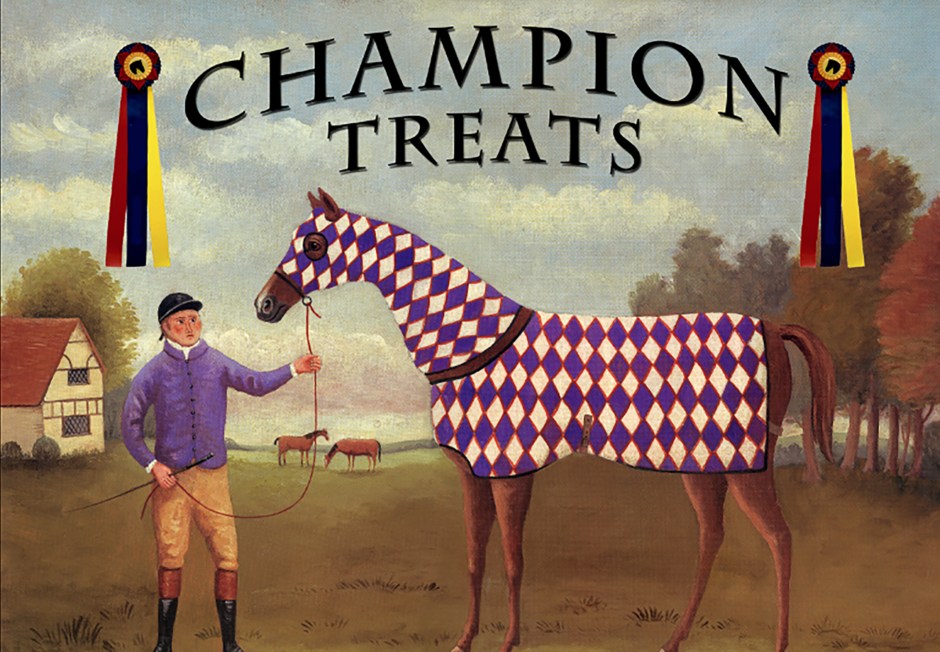
Pill Dispensers
Horse Care Products
Pill Dispensers:
The picture above contains both Large Dispensers and Small Pill Dispensers together for visual reference. (actual size varies). All Champion Treat horse treats are made with the same ingredients. All of the products manufactured here at Champion Treats no added sugar. All ingredients for Champion Treats, and the manufacturing process are United States based Horse Care products.
A local veterinarian here in Maryland gives us examples of what each of the products could be used to dispense:
Large slot pill dispenser is ideal for Pergolide, Bute tablets, Bute by the scoop and similar pills.
Small pill dispenser is ideal for Doxycycline, Hydroxyzine, Isoxuprine size pills(the size of Tylenol capsules) and the same size as our regular treat.
Because of amazingly low natural sugar content makes this treat safe for EMS, Gastric Ulcers, Tying-up (PMS), Exertional Rhabdomyolsis ER, Osteodhondritis Dissecans Disease OCD.
Regular Treats:
Champion Treats Low Sugar are made with ground roasted peanuts, ground sunflower seeds, ground sugarless peppermints, ground flax, ground oats, and sugarless peppermints Horse treats and our Pill Dispenser treats are available in 1 and 2 lb. containers.
There is almost a zero crumb factor, and the shelf life is fantastic.
Useful information and links:
Insulin resistance is a newly recognized problem in horses that may have been around a long time. You may be wondering what it is all about and how your horse may/may not be affected. To Read more click on the link. www.insulinresistance.htm
EQUINE METABOLIC SYNDROME: CAUSES, SIGNS, TREATMENT AND PREVENTION, for more see article Did you know?
Supporting Healthy Equine Blood Sugar
Using Treats for Positive reinforcement for Horse Training Video
What Causes Insulin Resistance in Horses (IR), What Does it Mean?
Equine (IR) is a result of the horse being resistant to insulin. Insulin in the body that allows blood cells to carry and deliver glucose, which is sugar used for energy. When a horse has (IR), they are unable to transport or provide sufficient insulin to the working muscles in the body.
One cause is over feeding your horse which causes the body to start rejecting insulin.
(IR) can also signify something more serious such as Cushing’s disease. This is when a tumor forms in the pituitary gland, which fluctuates the secretion of different hormones.
Six ways to identify potential of (IR)?
Spotting the clues prematurely is essential to prevent more serious developments in your horse. These six symptoms below are easy to spot and allow you to be certain that your horse is in full health.
- Thirst and Urination – One of the primary ways that you can spot a problem with horse’s health is with excessive urination and thirst. After you’ve bought a horse, you will soon learn how much is normal for the animal to drink and urinate. Should this change, it could mean that something is wrong and you are wise to seek a professional opinion.
- Weight Gain – As mentioned above, Horses that are overweight and remain so despite less feed and more exercise, could be displaying signs of equine (IR). Lower the amount of feed and increase exercise to see if the weight lessens. If nothing changes, seeking expert advice is suggested.
- Fat Deposits – This is in addition to general weight gain. Visible excess fat deposits, particularly in the crest, back or rear of the horse could signify (IR) too. These occur when the horse cannot process glucose properly. Look out for these when brushing and grooming, should you notice anything unusual seek expert advice.
- Less Energy – Reduction in energy levels should be clear to see. You may notice that you have to try much harder to get your horse to work or exercise. If it is appearing less energetic than usual then you may also want to seek help from a vet.
- Skin Conditions – Horses with (IR) tend to fall victim to skin horse health conditions. These include pasture scald and rain rot. These conditions might take longer than usual to heal, even with your best horse care provided. Consult your vet.
- Laminitis – As mentioned before this is common in diabetic horses and is very serious. Laminitis can also be described as inflammation of the hoof. If you spot this then it is worth getting your horse treated quickly.
IR Consequences
IR initially causes horses to be overweight, if not obviously obese. Many people equate a horse being “round” with being well cared for and healthy, but this is not the case. The extra weight puts unnecessary stress on your horse’s back, joints and heart.
IR also causes your horse’s body to react with exaggerated inflammatory responses. This combined with a tendency for blood vessels to spasm easily is thought to be why these horses are more prone to laminitis. In the advanced stages of IR, the horse actually begins to lose weight and muscle mass. The horses cells are “starving” for glucose that he is unable to get into them.
Early insulin resistance can only be diagnosed for sure with specialized blood tests, such as tubing the horse with glucose to see the insulin response or intravenous infusions of glucose and insulin. Later cases can be detected simply by checking the horse’s insulin. Testing performed by your veterinarian.





